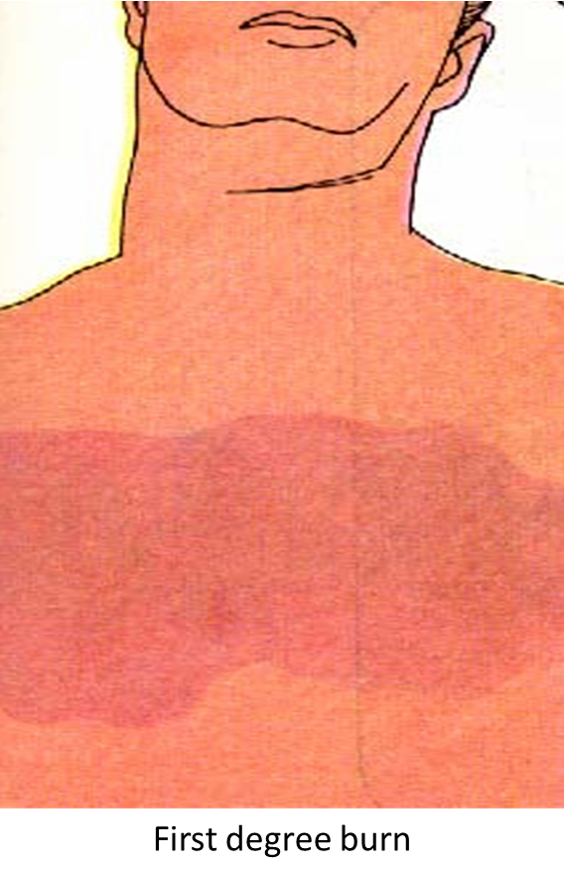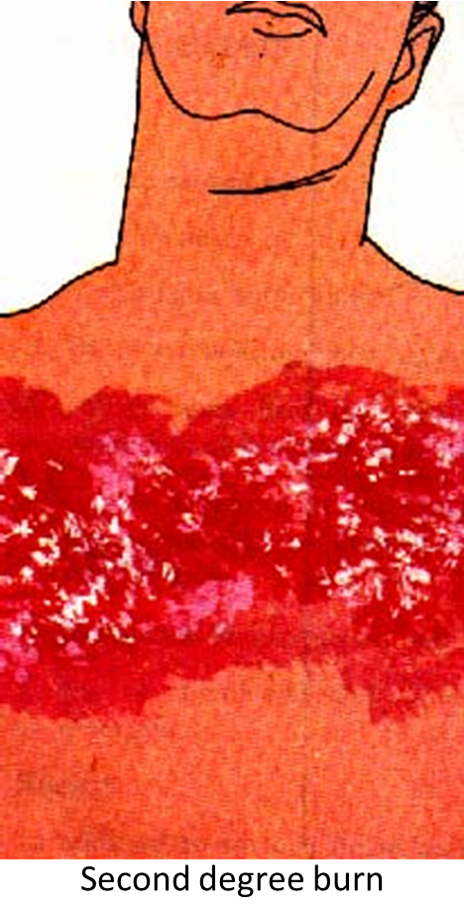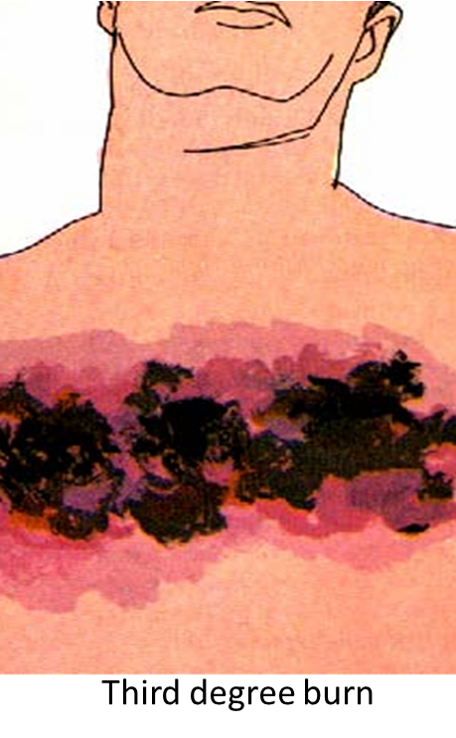Burn emergencies are injury to the skin and deeper tissues caused by hot liquids, flames, radiant heat, and direct contact with hot solids, caustic chemicals, electricity, or electromagnetic (nuclear) radiation. Skin exposed to temperatures as low as 120°F is burned after about 5 minutes.
Causes
- Burns are caused most commonly by:
- Carelessness with matches and cigarette smoking.
- Scalds from hot liquids.
- Defective heating, cooking and electrical equipment.
- Use of open fires that produce flame burns especially when flammable clothing is worn.
- Unsafe practices in the home in the use of flammable liquids for starting fires, for cleaning and for rubbing wax off floors.
- Immersion in over heated bath water.
- Use of chemicals such as dyes strong acids and strong detergents.
Hazards effects of burn
In addition to surface burns and the effect of heat on the blood and body tissues other than the skin, the hazards of fire include the following:
- Inhaling very hot air or irritating or poisonous gases including carbon monoxide.
- Asphyxia from insufficient oxygen in the air.
- Falls and injuries from collapsing walls in burning buildings.
Classification
Burns emergencies are usually classified according to depth or degree of skin or other tissue damage, often the degree will differ in various parts of the same affected area.
A. First Degree Burn
First -degree burns are those resulting from over exposure to the sunlight, contact with hot objects, or scalding by hot water or steam.

The usual signs are:-
- Redness or discoloration
- Mild swelling and pain
- Rapid healing
First Aid Measures
The objective of first aid for first degree burn is to relieve pain, prevent complications and treat for shock; usually medical treatment is not required.
- Apply cold water applications or submerge the burned area in cold water.
- Apply a dry dressing if it is necessary.
B . Second Degree Burn
Second-degree burns are those resulting from very deep sunburn, contact with hot liquids, and flash burns from gasoline, kerosene and other products. Second degree burns are usually more painful than deeper burns in which the nerve endings in the skin are destroyed.

The usual signs are:-
- Greater depth than first degree burns.
- Red or mottled appearance.
- Development of blisters.
- Considerable swelling over a period of several days.
- Wet appearance of the surface of the skin due to the loss of plasma through the damaged layers of the skin.
First Aid Measures
- Immerse the burned part in cold water.
- Blot to remove and dry gently.
- Apply freshly ironed cloths that have been wrung out in ice water.
- Apply dry sterile gauze or clean cloth as a protective bandage.
- Do not break blisters or remove tissue.
- Do not use an antiseptic preparation, ointments, spray, or home remedy on a severe burn.
- If the arms or legs are affected keep them elevated.
C. Third Degree Burns
Third degree burns can be caused by a flame, ignited clothing, immersion in hot water, contact with hot objects, or electricity. Temperature and duration of contact are important factors in determining the extent of tissue destruction.

The usual signs are:-
- Deep tissue destruction.
- White or charred appearance (at first the burn may resemble a second degree burn).
- Complete loss of all layers of the skin.
First Aid Measures
- Do not remove adhered particles of charred clothing.
- Cover burns with thick, sterile dressings or a freshly ironed or laundered sheet or other household linen.
- If the hands are involved, keep them above the level of the victim’s heart.
- Keep burned feet or legs elevated (the victim should not be allowed to walk).
- Have victims with face burns sit up or prop them up and keep them under continuous observation for breathing difficulty.
- Do not immerse an extensive burned area or apply ice water over it, because cold may intensify the shock reaction.
- Arrange transportation to the hospital as quickly as possible.
- If medical help or trained ambulance personnel does not reach for an hour or more and the victim is conscious and not vomiting give him a weak solution of salt and soda at home. (2 table spoon of sugar and 1 table spoon of salt in one liter of water).
- Do not apply ointment, commercial preparations, grease or other home remedies.
First Aid Measures when the Person’s Clothes are on Fire
- Put out the flames with cold water or sand if either is on hand.
- If water is not available, smother suppress the flames by laying the victim down and wrapping a blanket, coat or rug very lightly around him.
- Tear off smoldering clothing by seizing the non-burning areas of the material.
- Immerse the affected part in cold water.
- Remove any clothing which is soaked in boiling water, oil or other fluid
- Do not remove burnt clothing which has cooled.
- Remove any constricting items such as shoes, boots, rings and bracelets before swelling begins.
- Cover the area lightly with a sterile or very clean cloth or sheet.
Electrical Burns (Electrocution)
Electrical burns emergencies are usually deep. A patient who receives an electrical burn may also suffer cardiac arrest due to the electric current passing through his heart.
The first- aider must ensure that the patient is no longer in contact with the current before touching him; otherwise, you too will be electrocuted. If it is not possible to switch the current off, remove the patient from it by using clothing or wooden sticks. Do not use anything metal. If cardiac arrest has occurred external cardiac massage must be carried out, together with artificial respiration and treat the burn later.
Extent and Location of Burn
In addition to classification of burns according to depth or degree, burns are ordinarily described according to the extent of the total body surface involved .In general (an adult who has suffered from burns of 15 percent of his body surface, a child, 10 percent) wherever located requires hospitalization. Burns of the face are often associated with injury to the respiratory tract, and may obstruct breathing as swelling increases. Hence prompt medical attention is imperative.
Prevention of Heat Emergencies
A responsible attitude towards acquiring additional preventive information, particular in regard to fires and burns should lead you to resources beyond the basic discussion contained herein.
Injuries from Extreme Heat (Thermal Burn)
- Take care, of smoking and matches.
- Take care, of cooking and heating equipment.
- Take care, of fires of electrical origin.
Radiation Burns (Sun Burn and Others)
The usual source of radiation burn is an exposure to the ultraviolet rays of the sun during warm weather season. This can be prevented by minimizing the amount of exposure.
Chemical Burns
When irritating chemicals come in contact with the skin or mucous membrane, injury usually commences instantly and first aid should be immediate. Among such chemicals are acids and alkalis, some cleansing agents, lime and cement, petroleum products and some antiseptics.
Specific Fire or Burn Preventive Measures
- Install fire extinguishers in danger spots.
- Keep a garden hose near a faucet for use in case of fire.
- Install adequate insulation at all heating surfaces.
- Dispose of trash immediately.
- Repair or replace defective or in adequate electrical wiring.
- Perform the required maintenance on heating systems.
- Use only non flammable cleaning fluids.
- Hang clothes well away from stoves or fire places.
- Place curtains so that they will not blow in to flames from any stove, candle etc.
- Store flammable materials in a safe place.
- Do not overload electrical circuits.
- Supervise children playing near an open fire.
- Store matches in a metal container and out of reach of children.
- Do not smoke in bed.
- Do not smoke if you are sleepy.
- Provide adequate ashtrays throughout the house.
- Install home fire detectors.

